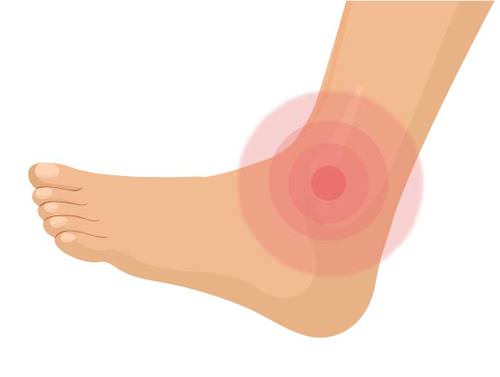11.61 炎炎反应
Section outline
-
Have you ever sprained your ankle?
::你扭过脚踝吗?Did you notice redness and swelling near the injury? These symptoms indicate that your body is attempting to fight off infection.
::你注意到血红和血肿了吗?这些症状表明你的身体正试图对抗感染。The Immune System's Second Line of Defense
::免疫系统第二防线The little girl pictured below ( Figure ) has a scraped knee. A scrape is a break in the skin that may let enter the body. If bacteria enter through the scrape, they could cause an infection. These bacteria would then face the body’s second line of defense. The second line of defense is also nonspecific, fighting many types of pathogens.
::位于下方(图)的小女孩膝盖被刮伤。 刮伤是皮肤破裂,可能进入身体。 如果细菌通过刮伤进入,它们可能造成感染。 这些细菌将面临身体第二防线。 第二防线也是不具体的,与许多类型的病原体作斗争。This little girl just got her first scraped knee. It doesn’t seem to hurt, but the break in her skin could let pathogens enter her body. That’s why scrapes should be kept clean and protected until they heal.
::这个小女孩刚刚第一次膝盖被刮伤。 这似乎并不痛,但她的皮肤破裂会让病原体进入她的身体。 这就是为什么刮伤应该保持干净和保护,直到愈合。Inflammation
::点火The body's second line of defense against pathogens includes the inflammatory response . If bacteria enter the skin through a scrape, the area may become red, warm, and painful. These are signs of inflammation . Inflammation is one way the body reacts to infections or injuries. Inflammation is caused by chemicals that are released when skin or other tissues are damaged. The chemicals cause nearby to dilate, or expand. This increases flow to the damaged area, which makes the area red and slightly warm. The chemicals also attract white blood cells called neutrophils to the wound and cause them to leak out of blood vessels into the damaged tissue.
::人体对病原体的第二防线包括炎症反应。 如果细菌通过刮痕进入皮肤, 该地区会变成红色、 温暖和痛苦。 这些是发炎的迹象。 发炎是身体对感染或伤害的反应方式之一。 发炎是由皮肤或其他组织受损时释放的化学物质引起的。 化学物质导致附近地区膨胀或膨胀。 这增加了向受损害地区的流动, 使该地区变得红色和略为温暖。 这些化学物质还吸引了白血细胞, 叫做中微营养化细胞进入伤口, 并导致它们从血管渗入受损的组织。White Blood Cells
::白血细胞What do these white blood cells do at the site of inflammation? The main role of white blood cells is to fight pathogens in the body. There are actually several different kinds of white blood cells. Some white blood cells have very specific functions. They attack only certain pathogens. Other white blood cells attack any pathogen they find. These white blood cells travel to areas of the body that are inflamed. They are called phagocytes , which means “eating cells .” Neutrophils are a type of phagocyte. In addition to pathogens, phagocytes “eat” dead cells. They surround the pathogens and destroy them. Sometimes it is said that the phagocyte engulfs the pathogen, and then destroys it. This process is called phagocytosis .
::这些白血细胞在炎症发作的地点做什么?白血细胞的主要作用是对抗体内的病原体。实际上,有几种不同的白细胞。有些白血细胞具有非常具体的功能。有些白细胞只攻击某些病原体。其他白血细胞攻击它们发现的任何病原体。这些白血细胞前往发炎的人体地区。这些白血细胞被称为发炎的地区。它们被称为发炎细胞,这意味着“发炎细胞 ” 。 神经系统是一种发酵细胞。除了病原体外,还有发酵细胞“食用”死细胞。它们环绕病原体并摧毁它们。有时据说,发酵细胞吞没了病原体,然后摧毁它。这个过程被称为发病。这个过程被称为发酵过程。White blood cells also make chemicals that cause a fever . A fever is a higher-than-normal body temperature. Normal temperature is 98.6°F (37°C). Most bacteria and that infect people reproduce fastest at this temperature. When the temperature is higher, the pathogens cannot reproduce as fast, so the body raises the temperature to kill them. A fever also causes the immune system to make more white blood cells. In these ways, a fever helps the body fight infection.
::白血细胞还产生致热化学物质。发烧是高于正常体温的温度。正常温度为98.6摄氏度(37摄氏度)。大多数细菌和感染者在此温度下繁殖最快。当温度升高时,病原体不能以最快的速度繁殖,因此身体会提高温度来杀死它们。发烧还导致免疫系统产生更多的白细胞。在这样的情况下,发烧会帮助身体抵抗感染。Summary
::摘要-
If pathogens enter your body, inflammation occurs.
::如果病原体进入身体 就会发炎 -
White blood cells called phagocytes travel to areas of the body that are inflamed.
::白血球 叫做发球细胞 前往身体发炎的部位
Review
::回顾-
Describe inflammation.
::描述炎症。 -
What is the main role of white blood cells?
::白血细胞的主要作用是什么? -
Describe phagocytosis.
::描述脑细胞病 -
A fever is a sign of infection. Why might it be considered a good sign?
::发烧是感染的征兆 为什么会被认为是好兆头?
-
If pathogens enter your body, inflammation occurs.

